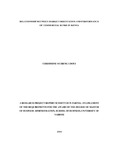| dc.description.abstract | In the prevailing, highly competitive business environment characterized globalization and
deregulation of markets, aggressive competition and ever-rising expectations of customers,
organizations need to adopt strategies that provide a competitive advantage within their
sector. Market orientation focuses on discovering and meeting the needs and desires of
customers through the product mix. Although a substantial amount of research on market
orientation and firm performance can be found in the marketing literature, little attention
has been paid in investigating the relationship between customer orientation, competitor
orientation and inter-functional and firm performance in the banking industry in Kenya.
The objective of this study was to determine the relationship between market orientation
and the performance of commercial banks in Kenya. The study adopted the descriptive
survey research design to determine and ascertain whether there existed any association
between MO and performance of commercial banks. The study population comprised all
the commercial banks in Kenya. Since the study population was manageable, the study
adopted the census survey in the collection of data and included all the 43 commercial
banks in Kenya. A structured, self-administered questionnaire was utilized in collecting the
data. The data collected from the study respondents was analyzed with the aid of the
Statistical Package for Social Scientists (SPSS) Version 20. Descriptive statistics were
used to summarize the data and establish characteristics of the study population and the
distribution of the response variations on market orientation strategies in the commercial
banks. The relationships between market orientation strategies and bank performance were
explored using correlation analyses by conducting the Pearson’s Product Moment
Correlation and regression analyses. Further analysis involved simple regression analysis
to determine the percentages in performance that may be explained by the variances in
market orientation strategies. The study established that there was a significant positive
relationship between and bank performance and customer orientation (r=0.489; n=39;
p<0.05; competitor orientation (r=0.76; n=39; p<0.05); inter-functional coordination
(r=0.57; n=39; p<0.05). Multivariate correlation and regression analysis revealed that at
p<0.05, MO strategies positively affected bank performance. Thus, the study
recommended that commercial banks should make deliberate attempts to recognize and
take into consideration their customers' needs better than competitors. If a bank is able to
recognize early enough which services customers need and design as well as implement
strategies to satisfy those needs, the bank will gain a competitive advantage over its
competitors thus gain a larger market share, hence better performance. Banks should
effectively analyze competitor strategies and actions and make efforts to counter the
actions by providing superior products and services to their customers. The bank managers
need to recognize that their institutions would do well if they develop inter-functional
coordination capabilities, which will support the competitive behavior of innovativeness. | en_US |

